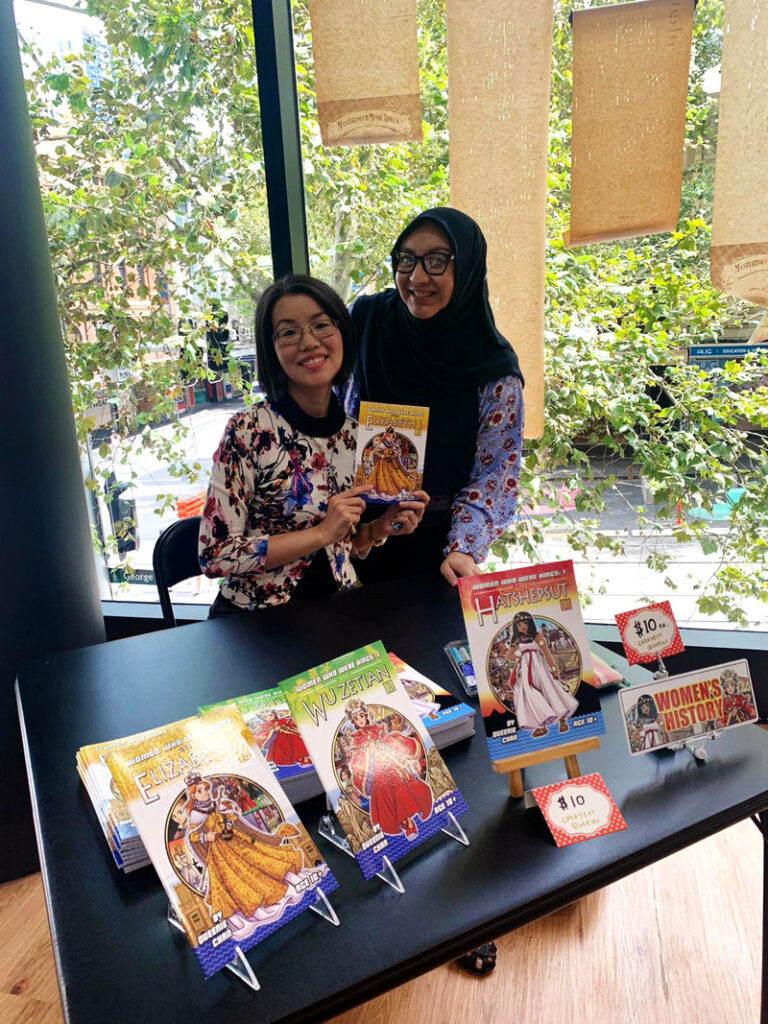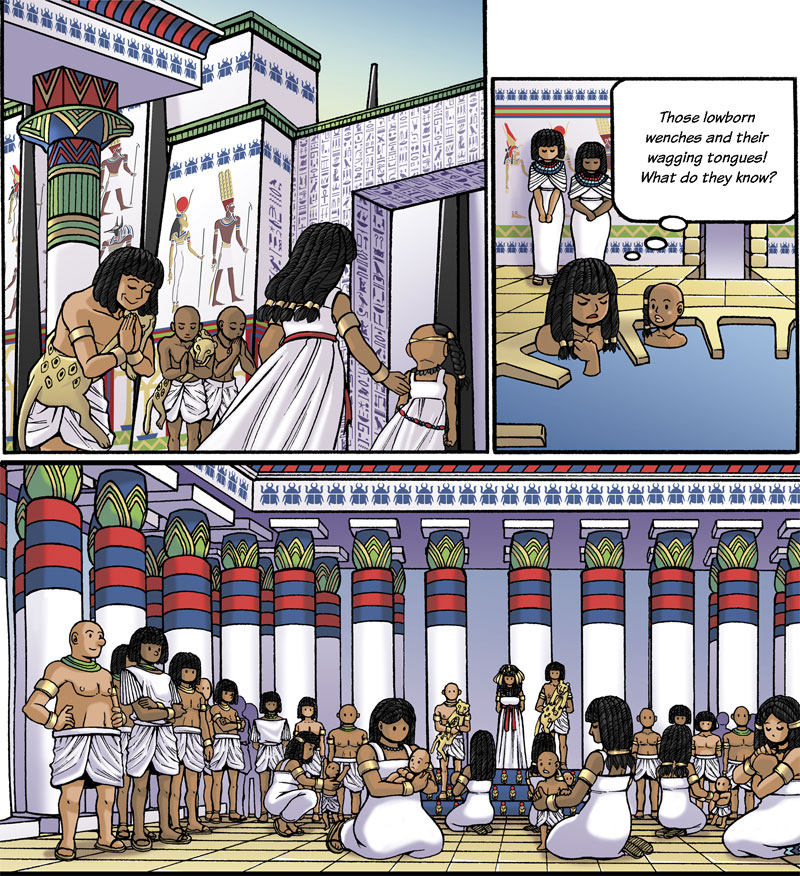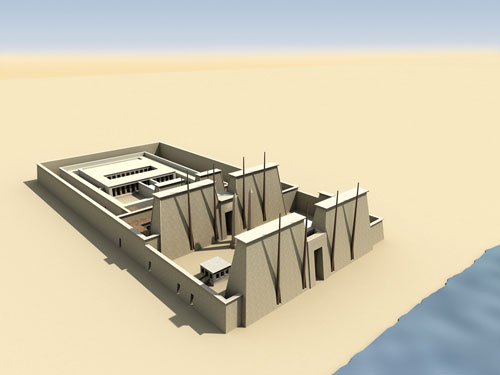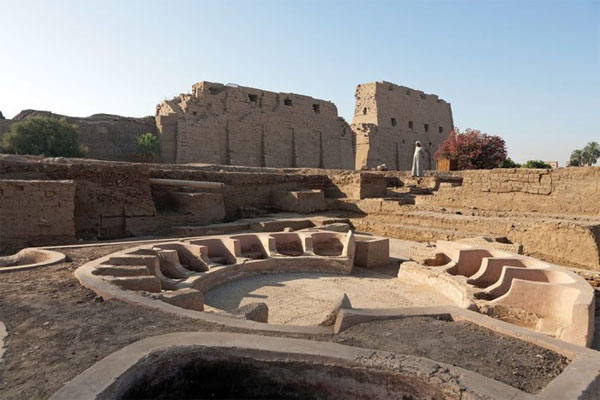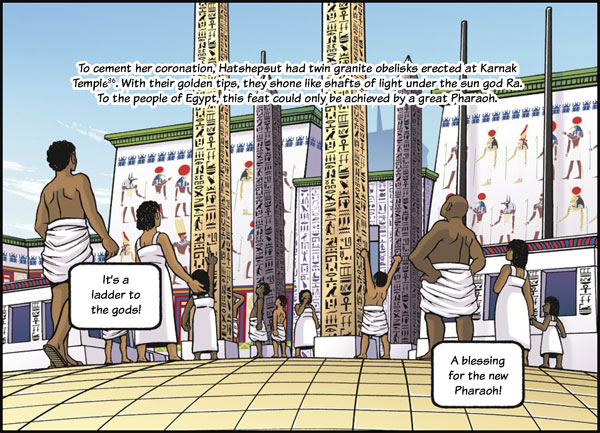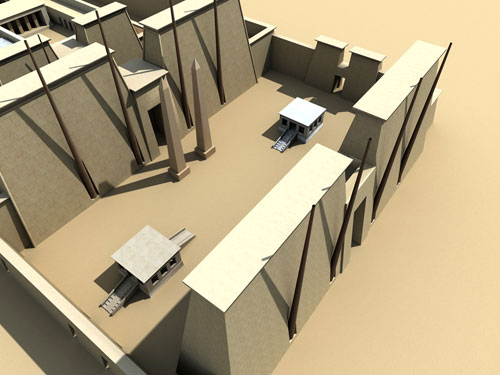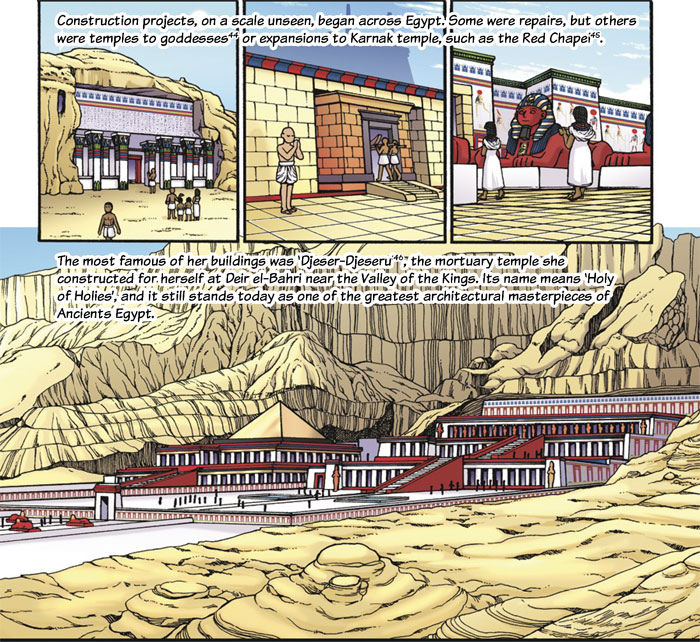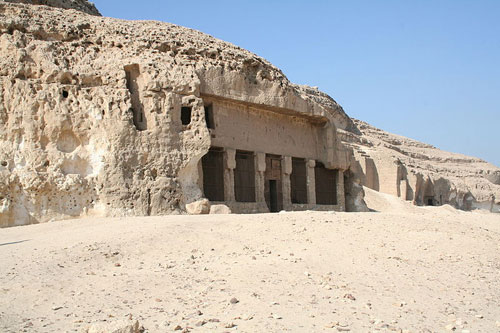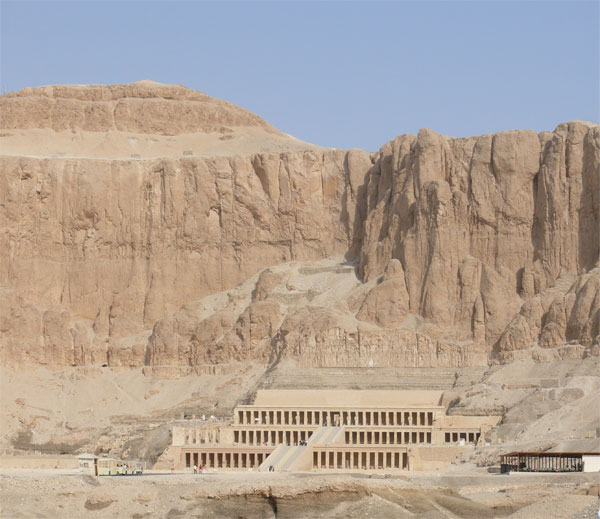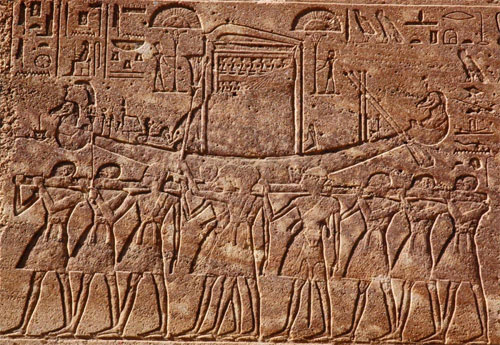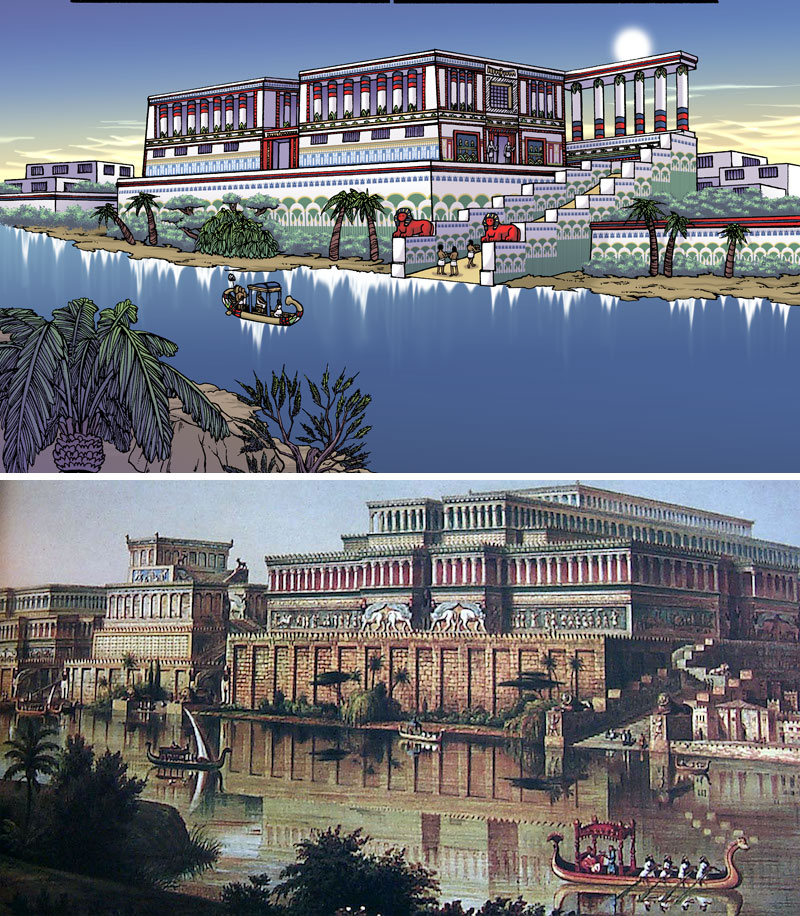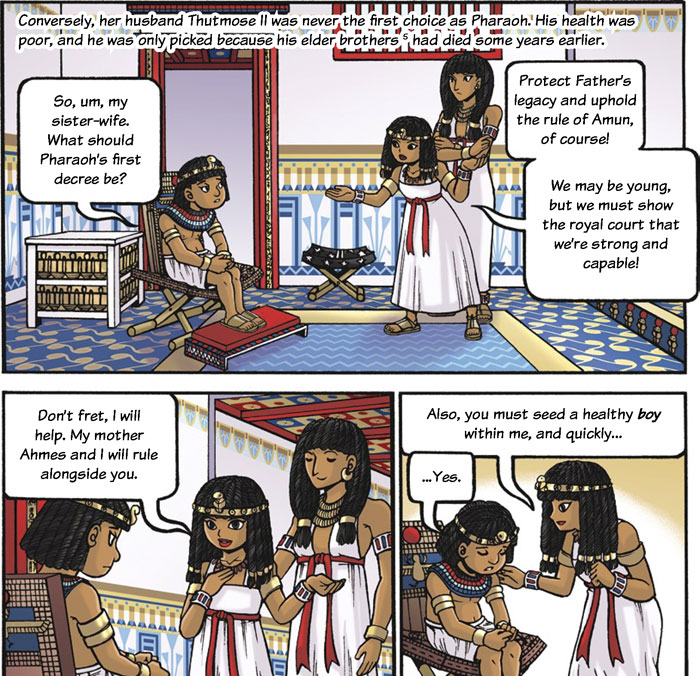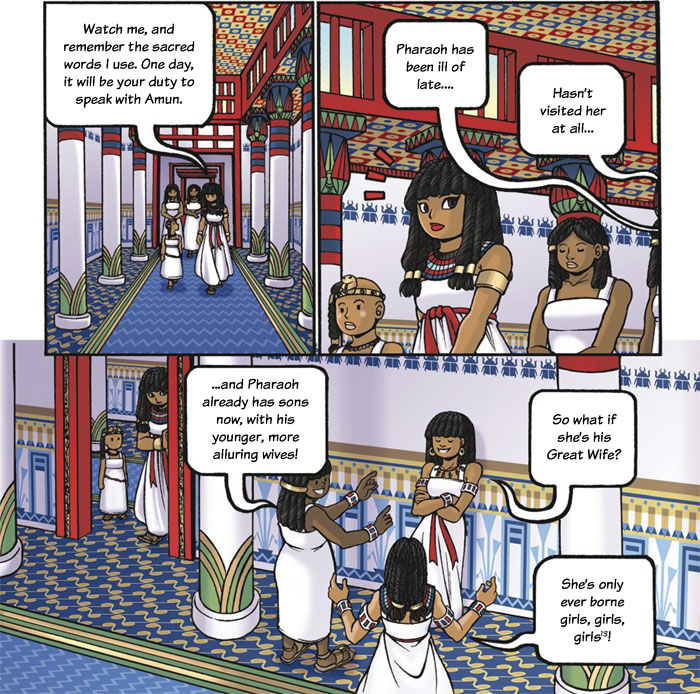Here are the footnotes and bibliography that should accompany the Hatshepsut Book I created. Feel free to email me if there are corrections required. Some of the books also have multiple editions, so if you have a different edition, the page numbers may not be correct.

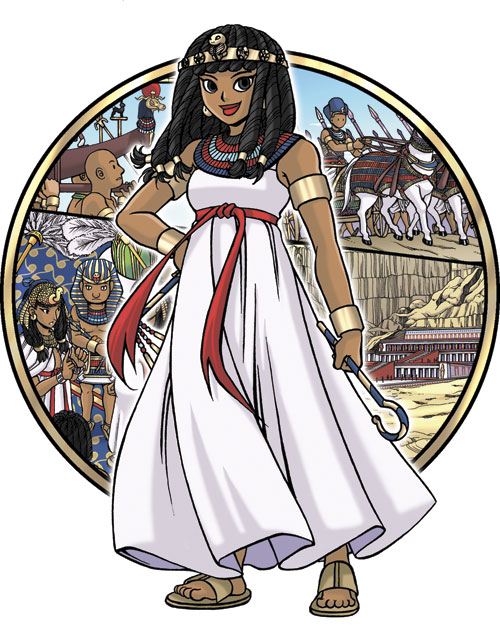

FOOTNOTES
1 (Laukens, 2015) The word ‘Pharaoh’ means ‘great house’, and there was no Egyptian word for ‘queen’. Egyptians only had the word ‘Pharaoh’ for king, and all high-status royal women were titled as ‘Pharaoh’s Great Wife’, ‘Pharaoh’s Sister’, ‘Pharaoh’s Daughter’ or ‘Pharaoh’s Mother’.
2 (Roehrig, 2006) PP. 11. 18th Century Royal women seemed to have been very powerful, since founding Pharaoh Ahmose I had a militarily and politically active mother and grandmother. He honoured both his grandmother Tetisheri on a cenotaph at Abydos, and his mother Ahhotep I on a stela which was later recovered from Karnak.
3 (Tyldesley, 1996) PP. 57-60. ‘God’s Wife of Amun’ was not a hereditary title passed from mother to daughter. Instead, it was a political and religiius office tied directly to the Pharaoh and his Great Wife or mother. It seemed to have been established in the reign of 18th Century founder Ahmose I for his Great Wife Ahmose Nefertari.
4 (Tyldesley, 1996) PP. 30-33. The Cult of Amun was a powerful religious institution, with temple lands that, in the latter 18th Dynasty, rivalled that of the Pharaoh’s own holdings. The position of ‘God’s Wife’ reached its greatest power in Hatshepsut’s time, and she was a big patron to the entire priesthood class. After Hatshepsut’s death, the position of ‘God’s wife’ was greatly diminished by Thutmose III for much of the 18th Dynasty, but was revived during the Third Intermediate Period with reduced status.
5 (Cooney, 2014) PP. 51-52. Thutmose II’s brothers Amenmose and Wadjmose had been named as heirs in reliefs commissioned by Thutmose I. It is unknown who their mother(s) were, but it is likely that they died young since their names vanished from the inscriptions after a certain time. It is generally believed that their mother was Mutnofret, also the mother of Thutmose II.
6 (Cooney, 2014) PP. 62. There was a rebellion in Nubia at the start of Thutmose II’s reign, which was brutally crushed. There were probably other campaigns in Syria and in Sinai during this time. It was also customary for the Egyptians to abduct the young sons of nobles from their defeated states as hostages, so they could be schooled in the ways of their conquerors and become obedient rulers of their vassal states. Daughters were married into the Pharaoh’s harems, and treated gently as a sign of goodwill.
7 (Cooney, 2014) PP. 23-23. Ahmes and Mutnofret had the titles ‘Pharaoh’s Sister’ and ‘Pharaoh’s Mother’, meaning that both were possibly the daughter and sister of the previous two pharaohs before Thutmose I. Mutnofret had the additional title ‘Pharaoh’s Daughter’, which might mean that she was a royal princess. However, Ahmes did not – which might mean that Mutnofret had the stronger bloodline. According to (Roehrig, 2006) PP. 11 though, it was common in the 18th Century for a princess to drop the title of ‘Pharaoh’s Daughter’ if they married a commoner, so it’s possible that Ahmes was a ‘Pharaoh’s Daughter’ who married Thutmose I. If that was the case, she would have ended up taking the title ‘Pharaoh’s Sister’ instead when Thutmose I was crowned. For the Pharaoh himself, having wives who were not of royal blood wasn’t uncommon in the 18th Dynasty. Many other women in the harem were pretty ‘ornaments’, meaning that they were possibly from the royal court, but not of royal blood themselves. Having highborn and well-connected wives may seem like a good way to drum up support, but in reality, it could also create succession struggles and clan disputes.
8 (Tyldesley, 1996) PP. 30-31. By the 18th Dynasty, the god Amun had become the principle god in the Egyptian pantheon. Amun was the creator of the universe, and when joined with Re as Amun-Re, he was seen as the ultimate source of the sun’s life-giving powers.
9 (Cooney, 2014) PP. 27-28. Conceiving a child was considered the responsibility of the Pharaoh, and women were not blamed if the pharaoh failed to produce children, or if the children were of the ‘wrong’ sex. In ancient Egypt, men were considered the progenitor of the life force that created the universe, while women were considered receptacles, or the fertile soil for his seed. For that reason, women were considered unable to renew themselves in the cycle of life necessary for universal balance to be maintained, which was why the Pharaoh must always be a man in Egyptian theology.
10 (Hill, 2010) Website. Bes was the wildly popular Egyptian dwarf god of war, but he was also the patron of childbirth and the home. He was associated with sexuality, humour, dancing and music, and his cult was popular with all segments of Egyptian society. A statue of him was often placed near the heads of women in labour, as it’s believed his dancing, shouting, and shaking of his rattle would keep evil spirits away. Bes was often said to stay with children after they were born, and when a baby smiles, it’s assumed that Bes was making funny faces and entertaining the child. He was often associated with Taweret in the New Kingdom, who was a fierce protection goddess of childbirth who was linked with the lion, the crocodile, but especially the hippo.
11 (Cooney, 2014) PP. 32-33. The Egyptian royals probably had palaces up and down the Nile river. Thebes was the religious capital, and so at times, the Pharaoh would go to the ceremonial palace at the Entrance of Karnak on the east bank and attend to the priests in its audience hall. Where the royal family actually lived is unknown—it’s possible that it was along the West Bank of Thebes, some distance away from the city of Thebes itself, which meant it was quieter and with more wildlife. Most Egyptian houses, including palaces, were made from unbaked mud bricks, so much of it didn’t survive apart from the stone elements such as columns, balustrades, door thresholds and sometimes toilets. The audience hall and throne room would have been the centrepiece of the palace.
12 (Tyldesley, 1996) PP. 82-83. 97. The exact length of this time period is unknown. Most people think Thutmose II died after only 3 years, but it’s assumed that even if Thutmose II managed to rule for 13 years, Hatshepsut (and Ahmes, if she was still alive) had a large role to play in the governing of Egypt. Part of the reason is that the foreign and domestic policies followed in the reign of Thutmose II was very similar to those during Hatshepsut’s reign. She was already depicted, alone and together with her husband, in several relief scenes from a gateway at Karnak dating back to Thutmose II’s reign. In them, she was shown as Pharaoh’s Great Wife and not as Pharaoh, performing rituals before the god Amun, while the Pharaoh wasn’t present. This is an example of her influence years before she became Pharaoh.
13 (Cooney, 2014) PP. 68-69. It is believed that Hatshepsut had other daughters besides Nefrure, but Nefrure might have been the only one to survive to adulthood. Child mortality rates were very high in ancient Egypt, and children often died of any number of illnesses and diseases before they came of age.
14 (Cooney, 2014) PP. 40-41. The heir to the Pharaoh is often referred to as the ‘Golden Horus’, due to the Pharaoh’s links to Osiris, the Egyptian god of the underworld. His association with death and rebirth meant that the Pharaoh himself is also representative of this cyclical life force, and as such, the myth of Horus and his quest to reunite the dismembered body of his father Osiris (murdered by his uncle Seth) was directly related to the chosen heir’s ascension to the throne as the next Pharaoh.
15 (Tyldesley, 1996) PP. 30-31. Egyptian harems were not quite like that of other countries such as the Turkish Seraglio or the Chinese Rear Palace. The Pharaoh’s Great Wife had their own palace and estates managed by male administrators, but it’s believed that all the other women lived in the harem palace, which is separate to the Pharaoh’s palace and with its own estate and income from tenant farmers. It seemed to be run as a self-sustaining community which also housed the nursery and the ‘Household of the Royal Children’, the most prestigious school in Egypt where princes are educated. This meant that the harem wasn’t so much a Pharaoh’s playground, but rather a dormitory which housed all female (and child) dependents of the Pharaoh, not just his wives. The harem was overseen by officials with titles like ‘Overseer of the Royal Harem’ or ‘Inspector of the Harem-Administration’, but there is no proof of there ever being eunuchs in the harem, nor is there indication that women were held there against their will. It also seemed that the lesser harem women were expected to earn their keep by doing chores like cooking, cleaning, nursing, and most likely weaving.
16 (Cooney, 2014) PP.53. When a mummy believed to be that of Thutmose II was found in the 19th Century, his skin was covered in lesions and scars. That does not necessarily indicate a disease—several mummies in the same batch also had the same scarring, which meant that it might have been caused by carelessness during mummification. Examination revealed an enlarged heart, which meant that the man suffered from arrhythmias and shortness of breath, which probably led to a lack of athleticism and a poor constitution. However, it cannot be definitively proven that this was the mummy of Thutmose II.
17 (Cooney, 2014) PP. 15-16. Thutmose I had no direct line to the previous pharaoh Amenhotep I, who ruled for 20 years and never sired a son. It was assumed Amenhotep I came to the throne young, since his mother Ahmes-Nefertari ruled on his behalf for a time. Either way, Thutmose I was a senior military leader whose connection to the existing royal family is unknown, though It’s safe to assume he had royal blood. However, he never billed himself as a ‘Pharaoh’s son’ (his father is unknown), and his mother was only described as ‘Pharaoh’s mother’. This could indicate that his mother came from a commoner background.
18 (Tyldesley, 1996) PP. 106-107. A barque is a ceremonial platform, the ‘ship’ of a god by which a god’s statue is carried. When the statues of Egyptian gods left their temples, which were considered their homes, they often traveled within a barque carried by the priests of the god. In Ancient Egypt, statues weren’t just considered a thing of beauty; they were considered of religious significance, and the embodiment of a person or a god’s spirit. The statue of Amun was probably solid gold, and shrouded from the eyes of everyone except the most senior of the god’s priests.
19 (Cooney, 2014) PP. 75-77. Thutmose III would later record this oracle in his annals, and make the same claims as Hatshepsut did. In his eyes, he was chosen and divine, and whether he truly believed it or not was irrelevant as this was how Egyptian pharaohs portrayed their kingship.
20 (Cooney, 2014) PP. 77. Isis (or Iset) was the name of Thutmose III’s mother, and it’s safe to say that while she was probably from a respectable family, there is no indication that she had royal blood. Her images were few, and there was only one reference to her being a ‘Pharaoh’s Mother’, which was made by Thutmose III. This lack of other titles indicate that she probably had no political connections.
21 (Dodson, 2015) PP. 1-10. Ancient Egypt was traditionally divided into two lands, and Pharaohs themselves were referred to as the ‘Pharaoh of the Two Lands’. These two separate kingdoms were originally united in 3000BC, but each maintained its own regalia: the hedjet or White Crown for Upper (Southern) Egypt and the deshret or Red Crown for Lower (Northern) Egypt.
22 (Tyldesley, 1996) PP. 116-119. Hapuseneb was possibly a distant relative of Hatshepsut, since he emphasised his childhood connection to the royal court. He was probably appointed by Hatshepsut’s mother Ahmes while she was still regent, and as such, was already a supporter of Hatshepsut when she came to be regent. As the high priest of Amun, he commanded a high amount of influence, and he was well-rewarded for his loyalty. So much that in his tomb, he didn’t even have any references to Thutmose III, only to Hatshepsut.
23 (Tyldesley, 1996) PP. 116-119. Ineni was already the royal architect and Overseer of Royal Buildings during the reign of Amenhotep I. He did a lot of work under these Pharaohs, and though Senenmut would eventually gain a number of building commissions during Hatshepsut’s reign, Ineni continued to oversee some of her other buildings and was probably consulted on a lot of them. It seemed that Ineni was favoured by Hatshepsut, since the steles on the walls of his tomb talked about how she praised him and granted him riches.
24 (Cooney, 2014) PP. 91-92. Ahmose Pennekhbet was from a distinguished Theban aristocratic family, and already served the Thutmosic family in some form when Hatshepsut came to power. Oddly enough, his duties seemed to overlap some with Hatshepsut’s overwhelming favourite Senenmut. Like Senenmut, Ahmose Pennekhbet was Nefrure’s tutor, and like Senenmut, had extensive control of the state’s finances. In addition, he monitored all the state’s taxes and expenses, opened the House of Gold with the Vizier each morning, and was also responsible for all the state’s wealth outside its treasuries, including commodities such as grain, other food stores, stone, metal and linen.
25 (Carney, 2001) It has been long believed that Hatshepsut, as a woman, undertook no military campaigns where she led an army. However, there are a few inscriptions from Deir El-Bahri that suggested she traveled with her army to the south to suppress a Nubian insurrection. There is also an unofficial graffito recovered from the Upper Egyptian island of Sehel (modern day Aswan), that was written on behalf of a bureaucrat called Ty who also served under Thutmose III. Sehel was like an ancient bulletin board—it was where people had announcements inscribed, and there are hundreds of unofficial announcements there. Ty claimed to have seen Hatshepsut overthrowing Nubian nomads, and inscriptions from Senenmut’s tomb as well as the stela of a man called Djehuty seems to suggest that Hatshepsut accompanied her army south to fight. So while Hatshepsut may have led armies, it’s highly unlikely that she herself was a warrior—as a princess, she would never have been trained in the warrior arts when she was a child.
26 (Tyldesley, 1996) PP. 80-81. It’s common for Egyptian royals in the 18th Dynasty to have nurses, some of whom are actually male tutors, while others were wet nurses. As such, many of them were named in reliefs and inscriptions. Hatshepsut herself had a wet nurse called Sitre who she seemed close to, and who was rewarded with a statue.
27 (Tyldesley, 1996) PP. 101. Senenmut is referring to the Westcar Papyrus, a Middle Kingdom collection of fantastic stories about the 4th Dynasty royal court. In it, one story about the Old Kingdom had a trio of goddesses help the Lady Reddjedet give birth to three triplet sons born of Ra. Hapshetsut was the first pharaoh to actually make this claim as part of her propaganda on the walls of her mortuary temple Djeser-Djeseru, and whose miraculous conception by Amun became ‘fact’ after she became Pharaoh.
28 (Tyldesley, 1996) PP. 11-12. Senenmut is holding ostraca, which are pieces of broken pottery that craftsmen used to plan or teach drawing or writing. They were cheap and widely used, and sketches were often made on these pottery for carvings before they were actually carved.
29 (Cooney, 2014) PP.85. Some of these were on blocks from Karnak temple, which show her and Thutmose II. These were probably made in memory of her husband, but it was also probably done to solidify her claim to the regency by emphasising her connection to Thutmose II.
30 (Cooney, 2014) PP. 101-102. The first recorded example was from Year 2 of Thutmose III’s reign, where Senma temple in Nubia showed her in the company of the gods, with a description of her action as an heir, builder and a ritual officiate—all masculine, kingly roles. Interestingly enough, Thutmose III was also in it, depicted as a grown man and not a child, meaning that Hapshetsut was already establishing her connection to his kingship. After that, she had Senenmut commission the Sehel relief, which was a monument text Senenmut had carved on the island of Sehel (Aswan), near the site where Hatshepsut’s obelisks were to be quarried. The inscription showed Hatshepsut as a queen, but the text referred to Hatshepsut as ‘the one to whom Re has given the kingship in truth’, and stressed her role as ‘Pharaoh’s Daughter, Pharaoh’s Sister, God’s Wife, Pharaoh’s Great Wife’, which was the first of Hatshepsut’s attempts to link herself with her father’s kingship.
31 (Cooney, 2014) PP. 102. This limestock block was found in 1930 by French archaeologist Henri Chevier, and it’s a block from the temple of Karnak. It had been dismantled, and it depicted Hatshepsut in a queen’s gown and with a Pharaoh’s atef crown. In it, Hatshepsut offered wine to the god Amun-Re, something only Pharaohs can do. She had also already taken her throne name Maatkare, and the titles ‘King of Upper and Lower Egypt’ and ‘Lady of the Two Lands’.
32 (Roehrig, 2006) PP. 12. Hatshepsut was not the first to depict herself in this manner. Sobekneferu of the 12th dynasty did too (she was a daughter of Amenemhat III who married her brother), although her reign was very brief. Sobekneferu was a queen regnant who ruled with no son, so Hatshepsut may have used her as a model.
33 (Laukens, 2015) The crook and the flail have been a symbol of power for a long time, and is associated with the god Osiris. It’s unknown what exactly these two represented, but it’s believed that the crook represented the role of Pharaoh as a shepherd to his people, while the flail seemed to have evolved from a shepherd’s whip, or a tool used to collect plant resin to produce incense. Both items are considered scepters, and there were other kinds of scepters that were often depicted with the pharaoh, the gods, priests and important officials.
34 (Cooney, 2014) PP. 106-108. It was customary for a Pharaoh to take on five names when they ascended to the throne, which was meant to symbolise holy and worldly power, and act as a road map for that Pharaoh’s reign. For Hatshepsut’s coronation, she had already taken the throne name ‘Maatkare’, which meant ‘Truth is the Soul of the Sun God Re’. She would also have changed her birth name to ‘Khnumt-Amun Hatshepsut’, which means ‘Hatshepsut, United with Amen’. Pharaohs were never referred to by their birth name—only by their titles or as ‘the One’. Her other names were ‘Wesretkau’, which meant ‘Powerful of Ka Spirits’, ‘Wadjrrenput’ which meant ‘She of the Two Ladies, Prosperous of Years’, and ‘Netjeretkhau’ which meant ‘Divine of Appearances’. Many of these names openly alluded to the feminine, so Hatshepsut wasn’t trying to hide her gender.
35 (Cooney, 2014) PP. 129. It wasn’t uncommon for Pharaohs to co-rule. Most involved a senior Pharaoh and his son, but Hatshepsut’s coronation and reign was unusual in that it was backwards to what was considered normal.
36 (Tyldesley, 1996) PP. 159-162. The last obelisks before these were done by Hatshepsut’s father Thutmose I. Hatshepsut’s first obelisks were probably commissioned and quarried to celebrate the reign of Thutmose III, and possibly even during the reign of Thutmose II. Since they took years to quarry, Hatshepsut took over them for her own coronation. Obelisks were religious objects meant to be a stone representation of the first beams of light to illuminate the world, and their tops were covered with gold foil so they shone. They were even regarded as living things—they had personal names, and offerings were made to them.
37 (Tyldesley, 1996) PP. 99-101. Dating Hatshepsut’s reign had always been difficult. Since she came to kingship in an unconventional manner, it seemed that she dated her regnal years to the start of Thutmose III’s reign, a move that seemed to show she had no intention of supplanting him, but which made her own dating system erratic. For example, Hatshepsut had been known to date her reign all the way back to the reign of Thutmose I, since she was trying to stress her connection to him by claiming her as his legitimate heir, a move she buttressed by de-emphasising the reign of Thutmose II.
38 (Tyldesley, 1996) PP. 145-147. It is unknown where the land of Punt was, though from the fauna and flora depicted in the reliefs in Hatshepsut’s funerary temple at Djeser-Djeseru, it was probably somewhere along the Eritrean/Ethiopian coast. By Hatshepsut’s time, it was a land that had been visited successfully before by Pharaohs considered blessed, including Sahure (Dynasty 5), Pepy I (Dynasty 6), Mentuhotep II (Dynasty 11), Amenemhat I (Dynasty 12), and Senwosret I (Dynasty 12). The last journey was already 500 year ago from Hatshepsut’s time.
39 (Tyldesley, 1996) PP. 144. Punt was not the first trading expedition Hatshepsut undertook. Before Punt, the court had also visited Phoenicia to collect timber for her ships, and exploited the mines of Sinai for copper and turquoise, which was attested to by various stela and inscriptions at the Wadi Maghara and Serabit el-Khadim.
40 (Cooney, 2014) PP. 136-140. Most of Hatshepsut’s high-ranking officials, like High Priest of Amun Hapuseneb, Ahmose Pennekhbet, and Vizier Urasermen were from distinguished backgrounds. They were often from old, distinguished Theban families where the positions were hereditary, and their fathers occupied similar positions before they took them over. Conversely, many of Hatshepsut’s new appointees weren’t from distinguished backgrounds, and many, including Chancellor Neshi who led the expedition to Punt, were just commoners. This was probably a deliberate move on Hatshepsut’s part–since her ‘new men’ had no political backgrounds, their influence depended on her alone, and so they had a vested interest in keeping her Pharaoh.
41 (Cooney, 2014) PP. 91-92. Senenmut resigned from his position as Nefrure’s tutor to take over his new role, and Nefrure was ‘God’s Wife of Amun’ by then, since Hatshepsut had to renounce that position when she became Pharaoh. Senenmut, being Hatshepsut’s clear favourite, was now one of the most powerful men in Egypt despite being from a commoner background. On top of that, he also impinged on some of the responsibilities of other high-ranking officials, which meant that he made some enemies among the influential families of Thebes. However, it was possible that Hatshepsut meant for her men of common backgrounds to have overlapping responsibilities with high-ranking nobles. It was a way to remain checks and balances within the system, and to ensure that neither group gained so much power that they could threaten her.
42 (Cooney, 2014) PP. 136. Under the old system, the temples of various cults were staffed by a few main priests and a variety of part-time personnel. In Hatshepsut’s time, she generously donated to temples, and in turn, they became fully professionalised, with multiple estates that had to be administered. The professionalisation of the priesthood had begun under Thutmose I, but was truly accomplished under Hatshepsut.
43 (Cooney, 2014) PP. 147. Hatshepsut was the first of Egyptian Pharaohs to build extensively in sandstone instead of limestone, and the strength of sandstone allowed her to build larger and taller buildings than before. The amount of building also allowed her plenty of space to sing her own praises and propagandise her reign and rule.
44 (Cooney, 2014) PP. 147. Hatshepsut built a temple for Pakhet, an obscure lion-headed goddess at Beni Hasan in Middle Egypt, which the Greeks later called Speos Artemidos after their own hunting goddess Artemis. She also built temples for Ptah at Memphis and Thebes, Thoth at Hermopolis, Khnum and Satet at Elephantine, Monthu at Armant, and a lot of other constructions in Nubia.
45 (Tyldesley, 1996) PP. 164. The Red Chapel was Hatshepsut’s contribution to Karnak Temple, a spot where countless Pharaoh would leave their mark. Her shrine was made of red quartzite, and was meant to be a barque shrine, which was a resting station for a god’s barque when the god’s sacred statue left their temple. It was possible that Hatshepsut didn’t complete the shrine in her reign.
46 (Tyldesley, 1996) PP. 172-176. This mortuary temple contained the relief sculpture of Hatshepsut’s divine birth, and also the expedition to Punt. In her lifetime, Hatshepsut promoted the cult of Hathor, the daughter of Amun, at her mortuary temple, and while her funerary cult was abandoned soon after her death, the cult of Hathor would continue to be celebrated here. The temple continued to be used for worship right up until the Ptolemaic period and even after, until it was abandoned in the 8th Century B.C.E. due to danger on the upper level from rock slides.
47 (Laukens, 2015) Egyptians had many sports similar to ours, including boxing, wrestling, archery, swimming, and athletics. They had a game, similar to hockey, that was played with a coloured ball and bats with a curved end made of long palm tree branches. Other games involved a hoop and two sticks, where the two competitors tried to pull the hoop in their direction while making the hoop stay upright. In Hatshepsut’s time, royal sports would have been neglected as it was a male pastime, but Thutmose III would have performed a lot of sports since it was important to present the image of a strong, active Pharaoh.
48 (Tyldesley, 1996) PP. 129. Mirrors did not exist in Ancient Egypt yet. People used discs of polished bronze or other metals to check their reflection. Beauty was considered holy, and at Hatshepsut’s dressing table, you would have found crushed frankincense used as kohl eyeliner, which both men and women used since it helped protect them from eye infection. Apart from kohl made from lead, eye paint made from malachite, and red stains for cheeks and lips made from ochre, they also dyed their hair and painted their nails with henna. Many Egyptian men and women also wore wigs made of human hair, which meant that Hatshepsut possibly had a shaven bald head.
49 (Tyldesley, 1996) PP. 88-90. It was unknown whether Nefrure ever married Thutmose III, though Nefrure certainly acted as ‘God’s Wife’ in her mother’s reign. Little was known about Nefrure after Hatshepsut’s death—someone of her lineage would most certainly be destined to become Thutmose III’s Great Wife, but neither of Thutmose III’s two Great Wives were Nefrure, leading to the speculation that Nefrure might have died early. She might also have fallen out of favour.
50 (Tyldesley, 1996) PP. 185-196. Senenmut’s relationship to Hatshepsut is the cause for much speculation in Egyptology. They were certainly close, and it was suggested that they might have been lovers. Not only did Hatshepsut allow Senenmut to tunnel his tomb close to hers in the Valley of the Kings, something that was quite bold, but he also managed to get dozens of images of himself engraved in her mortuary temple of Djeser-Djeseru. This sort of thing had no precedence in Pharaonic history, and that, coupled with the fact that Senenmut had no wife or child, made people think their relationship was not platonic. He faded in prominence after her 16th year of reign, meaning that he might have died since he was probably 20 years her senior.
51 (Cooney, 2014) PP. 159-162. The Sed Festival was traditionally meant to celebrate 30 years of a Pharaoh’s reign, but Hatshepsut and Thutmose III celebrated it only after 15 years of rule. In Hatshepsut’s case, she took the reigns of Thutmose I, II and III and added them together, making it a celebration of a 30-year Thutmosic reign. It was a shrewd political move on her part, since everyone loved a spectacle, and she threw one of the greatest parties that an Egyptian could have seen in their lifetime. Not only did it affirm the power of the Thutmosic family tree, but it also showed off Thutmose III as a confident, young Pharaoh.
52 (Cooney, 2014) PP. 189. The date of Hatshepsut’s death is unknown, and there was also no evidence of abdication. There was no evidence of foul play either—if Thutmose III had wanted the throne to himself, he could have launched a military coup at any point in time. Her exact age at death was also unknown, though she could not possibly have been younger than 38 years old. The average life expectancy of an Egyptian was around 30 years old.
53 (Cooney, 2014)PP. 192-193. When Hatshepsut died, there appeared to have been a number of revolts. An Egyptian account of the events have been preserved, where one official claimed ‘From Yerdi to the ends of the earth, there is rebellion’. It was likely that many areas under Egyptian control rebelled, but it was clear that Thutmose III launched his campaign against the Syrians first, which he was quite successful at. Thutmose III would launch 17 campaigns in his 33 years of solo rule, and would expand the Egyptian empire past Thutmose I’s territory.
54 (Laukens, 2015) The ‘Field of Reeds’ was the Egyptian afterlife, a paradise that was a mirror image of life on earth. It was a land where Osiris, the lord of the Underworld, ruled, and Osiris was commonly associated with dead Pharaohs, while the current living Pharaoh was associated with Osiris’ son Horus.
55 (Tyldesley, 1996) PP. 212-213. Hatshepsut and Thutmose I’s bodies have never been properly identified. Hatshepsut’s old tomb (the one that was built for her when she was a Great Wife) had been found, but she was never buried in it since she became a Pharaoh afterwards. It seemed that while she was buried with her father, Thutmose III ended up moving the body of Thutmose I, probably because the grave had been found by graverobbers and ransacked. Later Pharaohs would also move the bodies of the 18th Dynasty Pharaohs around, so it’s unknown which body is Hatshepsut’s even though a number of female mummies had been found.
56 (Tyldesley, 1996) PP. 215. Thutmose III wasn’t just a great warrior-general, though he certainly felt most at home with his army. He was also a great builder and athlete. In his spare time, he composed literary works, and his interests ranged from botany, reading, history, religion and even interior design. He reigned for 53 years in total (including the 22 years of Hatshepsut’s reign), and celebrated another Sed festival in his time. He was succeeded by his son Amenhotep II after a period of co-rule.
57 (Cooney, 2014) PP. 219-222. The destruction of Hatshepsut’s legacy is one of those great mysteries of Egyptology that will never be truly understood. Sexism is a possible reason—removing all traces of a female king to create an unbroken male line is more in line with Egyptian ideas of kingship and the supposed place of a woman. Other reasons include earlier, simpler theories, like the possibility that Thutmose III was a petty man who hated his aunt and wanted revenge. However, this theory doesn’t hold, because while Thutmose III walled up Hatshepsut’s obelisks and remove her statues from Karnak, it was normal for a Pharaoh to remove the statues and buildings of previous Pharaohs for their own building projects. Hatshepsut herself walled up some of Thutmose II’s buildings for her own projects. The bulk of the destruction also had occurred around 20 years after Hatshepsut’s death, and had left images of her as ‘Great Wife’ and ‘God’s Wife’ intact—if Thutmose III hated her so much on a personal level, wouldn’t he have attacked all her images? Lastly, while the damage was extensive, it was also shoddy—we still have a lot of images of her left after all, which showed that the destruction was not thorough, and the majority of the images attacked tended to be her most public images. One explanation was that Thutmose III was motivated politically because of a succession crisis in the 20th year of his reign, in regard to his son Amenhotep II, who was made heir after his original heir Amenemhat died unexpectedly. Amenhotep II was birthed by a non-royal mother, so people could have been questioning his lack of royal blood. Who were these people? No one knows, but one possibility is that they may have claimed descent from Hatshepsut’s side of the family. If that was the case, it could be Thutmose III’s reasoning behind removing all the reliefs that show Hatshepsut to be the senior king to Thutmose III, because that would obviously be fuel to these people’s claims. Once Amenhotep II was solidly on the throne, first as co-king and then alone, the destruction seemed to have ceased.
58 A quote from Egyptologist Henry James Breasted.

BIBLIOGRAPHY
Books
- Cooney, Kara. “The Woman Who Would be King: Hapshetsut’s Rise to Power in Ancient Egypt”. USA: Crown Publishers, 2014.
- Tyldesley, Joyce. “Hatchepsut: The Female Pharaoh”. England: Penguin Group, 1996.
- Dodson, Aidan. “Monarchs of the Nile”. Egypt: American University in Cairo Press, 2015. Third Revised Edition.
- Shaw, Ian. “Ancient Egypt: A Very Short Introduction”. United States, Oxford University Press, 2004.
- Galford, Ellen. “Hatshepsut: The Girl Who Became a Great Pharaoh”. United States: The National Geographic Society, 2005.
- Tyldesley, Joyce. “Chronicle of the Queens of Egypt: From Early Dynastic Times to the Death of Cleopatra”. USA: Thames & Hudson, 2006. PP. 88-108.
- Robins, Gay. “Women in Ancient Egypt”. USA: British Museum Press, 1993. PP. 44-52. PP.149-156.
- Hope, Colin A. “Gold of the Pharaohs”. Australia: Museum of Victoria, 1988.
- Roehrig, Catherine H. et al. “Hatshepsut: From Queen to Pharaoh”. USA: The Metropolitan Museum of Art, 2006.
Journal Articles
- Carney, Elizabeth D. “Women and Military Leadership in Pharaonic Egypt”. Greek, Roman and Byzantine studies 42 (2001): PP. 25-41.
Websites
- Leser, Dr. Karl H. “Maat-Ka-Ra Hatshepsut”. Maat-Ka-Ra Hatshepsut. N.p., 6 Dec. 2013. Web. 1 Aug. 2017. (http://www.maat-ka-ra.de/)
- Sullivan, Elaine (Project Coordinator). “Digital Karnak: Time Map”. Digital Karnak. UCLA, 2008. Web. 1 Aug. 2017. (http://dlib.etc.ucla.edu/projects/Karnak/)
- Laukens, Dirk. “Ancient Egypt Online”. Ancient Egypt Online. N.p., November 2015. Web. 4 Sep. 2017. (http://www.ancient-egypt-online.com/)
- Hill, J. “Ancient Egypt Online: Bes”. Ancient Egypt Online. N.p., 2010. Web. 1 Aug. 2017. (http://ancientegyptonline.co.uk/bes.html)
- Shaw, Garry J. “The Daily Life of a Pharaoh”. Dr Gary J. Shaw. Al Rawi: Egypt’s Heritage Review, issue 5, 2013. Web. 7 Sep. 2017. (http://garryshawegypt.blogspot.com.au/2014/03/the-daily-life-of-pharaoh.html)



